How Often Should You Fertilize Houseplants? Tips for Strong, Healthy Growth
- April 15, 2024
- 0 comment
Maximize houseplant growth with our fertilization guide. Discover the optimal frequencies and essential tips to boost health and vitality. Fertilizing houseplants is essential for their growth and health, acting much like vitamins and supplements for humans. By providing the necessary nutrients, fertilizers help strengthen plants, enhance their beauty, and increase their growth rate.
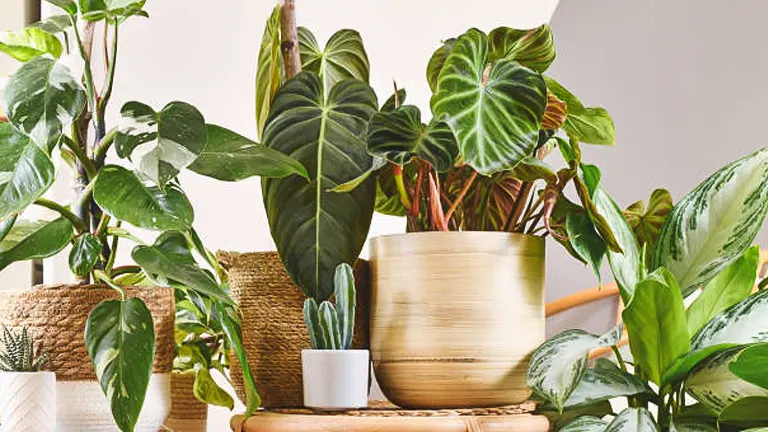
However, the key to effective fertilization lies not only in choosing the right type of fertilizer but also in determining the correct frequency of application to avoid the detrimental effects of over or under-fertilizing. This article will explore various types of houseplants and their specific needs, decipher fertilizer labels, and suggest proper techniques and schedules for fertilizing your indoor garden.
Table of Contents
- The Basics of Houseplant Care
- Choosing the Right Fertilizer
- Assessing Fertilization Needs by Plant Type
- Optimal Timing and Frequency for Fertilizing Houseplants
- Fertilizing Potted Houseplants
- Seasonal Adjustments and Advanced Tips
- Common Mistakes to Avoid in Houseplant Fertilization
- Conclusion
- FAQs
The Basics of Houseplant Care
Essential Nutrients
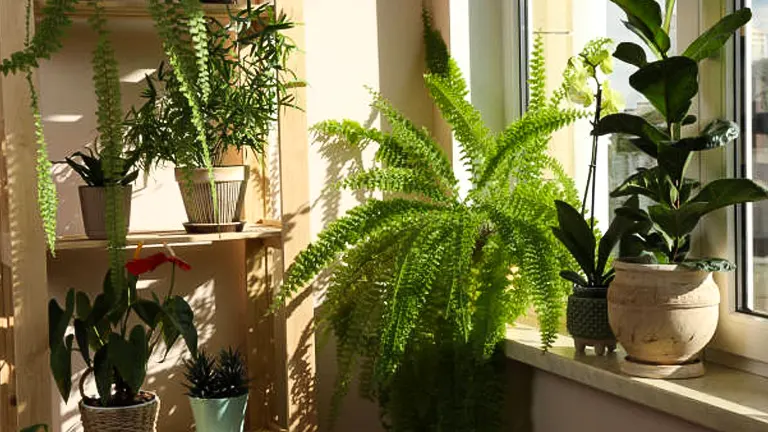
All houseplants require a balanced intake of macro and micronutrients, each contributing uniquely to the plant’s physiological functions. Below is a detailed overview of these nutrients:
- Nitrogen (N): Essential for the synthesis of amino acids, which are the building blocks of proteins. It plays a critical role in leaf and stem growth by facilitating chlorophyll production, which is vital for photosynthesis.
- Phosphorus (P): Supports the development of roots and blooms by participating in the storage and transfer of energy throughout the plant. This nutrient is crucial for cellular processes, such as photosynthesis and nutrient movement within the plant.
- Potassium (K): Regulates the plant’s water balance, enzyme activation, and photosynthesis. Potassium is crucial for the opening and closing of stomata, which controls the exchange of water vapor, oxygen, and carbon dioxide.
Micronutrients
These are needed in smaller quantities but are equally vital. Iron (Fe) is crucial for chlorophyll synthesis and acts as a catalyst in photosynthesis and respiration. Manganese (Mn) contributes to chloroplast creation and helps convert nitrogen within the plant. Zinc (Zn) is involved in protein synthesis and growth regulation, often concentrated in the growing parts of roots and shoots.
Identifying Nutrient Deficiencies
Deficiencies of these nutrients manifest in various symptoms:
- Nitrogen deficiency: Yellowing of older leaves as nitrogen is mobilized to new growth areas.
- Phosphorus deficiency: Reduced growth and dark, bluish-green leaves due to insufficient energy transfer.
- Potassium deficiency: Scorched leaf edges, weakened stems, and stunted growth due to poor stomatal control.
Nutrient Deficiency Table
| Nutrient | Function | Deficiency Symptoms |
|---|---|---|
| Nitrogen (N) | Protein synthesis, chlorophyll formation | Yellowing of older leaves, stunted growth |
| Phosphorus (P) | Energy transfer, root and bloom development | Dark, bluish-green leaves, reduced growth |
| Potassium (K) | Water balance, stomatal control | Browning leaf edges, weak stems |
| Iron (Fe) | Chlorophyll synthesis, enzyme catalyst | Chlorosis (leaf yellowing) starting with younger leaves |
| Manganese (Mn) | Photosynthesis, chloroplast production | Interveinal chlorosis, spotted or patched leaves |
| Zinc (Zn) | Growth regulation, protein synthesis | Stunted growth, distorted leaf formation |
Nutrient Uptake Fundamentals
The absorption of nutrients by houseplants is highly influenced by soil conditions, particularly pH levels:
- Optimal pH Levels: Nutrient availability peaks in slightly acidic to neutral soils (pH 6.0-7.0). At these pH levels, the solubility of essential nutrients is optimal, facilitating better uptake by the root system.
- Soil Texture and Structure: Loamy and sandy soils are preferred for most houseplants as they allow for adequate water drainage and proper root penetration. Heavy clay soils can be amended with organic matter to improve their texture.
Factors Affecting Nutrient Uptake
- Watering Practices: Over-watering can leach nutrients deep beyond the reach of plant roots, while under-watering can lead to concentrated salts in the soil, which may inhibit nutrient uptake.
- Light Conditions: Light intensity affects photosynthesis rates and, consequently, the plant’s nutrient demands. Low light conditions slow down photosynthesis and hence the requirement for nutrients.
- Temperature and Humidity: Both high and low temperatures can affect enzyme activity involved in nutrient uptake. Humidity affects transpiration rates; low humidity can increase transpiration and nutrient demand.
By understanding these essential care elements, you can better nurture your houseplants, ensuring they remain healthy and vibrant. Regularly check your plants for signs of nutrient deficiency and adjust your fertilization practices accordingly to maintain the ideal growing environment.
Choosing the Right Fertilizer
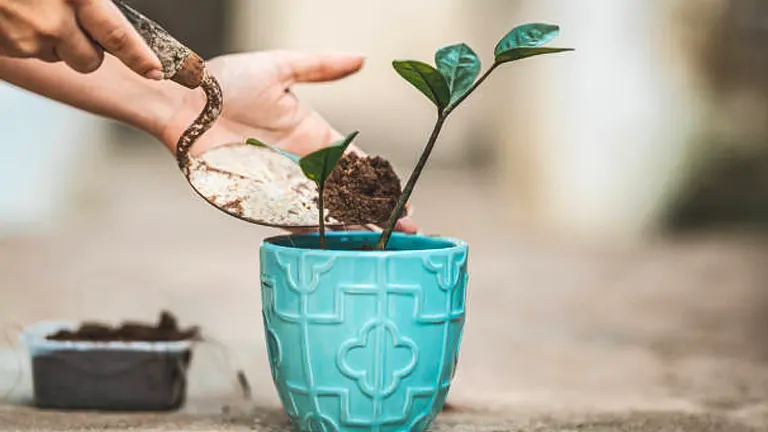
Selecting an appropriate fertilizer is critical for meeting the specific nutritional needs of houseplants, which vary significantly between different types of plants and their growth conditions.
Organic vs. Synthetic Fertilizers
Organic fertilizers are derived from natural sources such as compost, manure, or bone meal. These fertilizers release nutrients slowly, improving soil structure and microbial health, which benefits plant roots in the long term. However, their nutrient ratios are not precisely controlled, and results may be slower to observe.
Synthetic fertilizers are manufactured chemicals that provide nutrients in exact ratios and dissolve quickly to offer immediate benefits. While they can improve plant growth efficiently, their overuse can lead to nutrient runoff and salt accumulation, which may harm plant roots and diminish soil quality over time.
Forms of Fertilizers
Fertilizers come in various forms, each with specific applications and benefits:
- Granular fertilizers are easy to apply and slow-releasing, making them ideal for long-term nourishment with less frequent application needs.
- Liquid fertilizers are fast-acting, providing nutrients that are readily available to plants. They need to be applied more frequently and are perfect during the peak growing seasons when plants are most active.
Assessing Fertilization Needs by Plant Type

Each category of houseplants has distinct fertilization requirements that cater to their natural growth habits and environmental adaptations. The following detailed analysis and accompanying table will help gardeners provide the optimal nutrients for different types of houseplants.
1. Foliage Plants
Plants like ferns, philodendrons, and monsteras are primarily grown for their vibrant leaves and require a nutrient mix that promotes lush, healthy foliage.
- Nitrogen Requirement: High (Promotes leaf growth and enhances green color)
- Ideal Fertilizer Ratio: High nitrogen formulations, typically around a 3-1-2 ratio (e.g., 24-8-16)
- Fertilization Frequency: Every 4-6 weeks during spring and summer; reduce to every 8-10 weeks during fall and winter
- Scientific Insight: Nitrogen is critical for chlorophyll production, which is necessary for photosynthesis. An N-P-K ratio favoring nitrogen supports rapid leaf expansion and vibrant coloration.
2. Flowering Plants
These include beauties such as African violets, orchids, and bromeliads, which flourish with phosphorus-rich fertilizers that enhance bloom production.
- Phosphorus Requirement: High (Encourages blooming)
- Ideal Fertilizer Ratio: Bloom boosters, typically with higher phosphorus content, such as 15-30-15
- Fertilization Frequency: Apply every 2-3 weeks during the blooming phase; reduce significantly or pause when not in bloom
- Scientific Insight: Phosphorus is essential for energy transfer within the plant, which is vital during the blooming period. It helps in the formation of flowers and supports root development.
3. Succulents and Cacti
Adapted to arid environments, these plants require minimal fertilization. Excessive nutrients can dilute their natural flavors and potentially harm their health.
- Balanced Nutrition Requirement: Low
- Ideal Fertilizer Ratio: Lower nitrogen and balanced ratios such as 5-10-5
- Fertilization Frequency: Once in early spring and optionally once in mid-summer
- Scientific Insight: Succulents and cacti have adapted to thrive in nutrient-poor soils. A mild, balanced fertilizer supports their needs without causing nutrient burn, which can lead to stretched, discolored, and weak plants.
4. Common Potted Plants
Typical houseplants like pothos, spider plants, and peace lilies benefit from regular but moderate fertilization.
- Balanced Nutrition Requirement: Moderate
- Ideal Fertilizer Ratio: Balanced formulations like 10-10-10 or 20-20-20
- Fertilization Frequency: Every 6-8 weeks during the active growth season
- Scientific Insight: These plants require a steady supply of all three primary nutrients (N, P, K) to support leaf development, root strength, and sometimes modest flowering.
Fertilization Overview Table
| Plant Type | Nitrogen (High/Moderate/Low) | Phosphorus (High/Moderate/Low) | Potassium (High/Moderate/Low) | Recommended N-P-K Ratio | Fertilization Frequency |
|---|---|---|---|---|---|
| Foliage Plants | High | Low | Moderate | 24-8-16 | Every 4-6 weeks (Active) |
| Flowering Plants | Moderate | High | Moderate | 15-30-15 | Every 2-3 weeks (Bloom) |
| Succulents and Cacti | Low | Moderate | Moderate | 5-10-5 | Once in spring, optional summer |
| Common Potted Plants | Moderate | Moderate | Moderate | 10-10-10 or 20-20-20 | Every 6-8 weeks |
Optimal Fertilization Practices
- Adjust Quantities for Pot Size: Smaller pots require less fertilizer compared to larger ones. Diluting stronger fertilizers or using slow-release options can prevent nutrient burn in compact soil spaces.
- Monitor Plant Response: Watch for signs of both under and over-fertilization (e.g., leaf discoloration, stunted growth). Adjust the fertilizer type, ratio, and application frequency based on the plant’s health and growth patterns.
- Seasonal Adjustments: Reduce or halt fertilization in the dormant winter months for most plants to prevent the accumulation of unused nutrients which can lead to salt buildup and root damage.
Optimal Timing and Frequency for Fertilizing Houseplants
Understanding when and how often to fertilize is crucial for maintaining healthy houseplants. Here’s how you can create an effective fertilization schedule:
Best Time to Fertilize
Seasonal Guidance:
- Spring and Summer: This is the active growth period for most houseplants. Fertilizing during these seasons supports lush growth and blooming.
- Fall and Winter: During these months, most plants enter a dormant phase. It’s generally best to reduce fertilization since the plants’ nutrient needs decrease significantly.
Time of Day:
- Morning: Ideal for fertilizing plants as it gives them time to absorb the nutrients during their peak photosynthetic hours.
- Avoid Evenings: Fertilizing in the evening can lead to potential issues such as fungal growth, as temperatures drop and moisture can linger on the foliage or in the soil.
Fertilization Frequency
General Frequency Guidelines:
- Weekly to Bi-weekly: Use a diluted liquid fertilizer. This frequent, mild feeding is particularly beneficial during the peak growth phase.
- Monthly: Apply a stronger dose if fertilizing less frequently or if using slow-release forms like spikes or granular fertilizer.
- Seasonal Adjustments:
- Reduce Frequency in Winter: For most plants, a light application every 6 to 8 weeks is sufficient. Some plants may not require winter fertilization at all, especially if they are completely dormant.
Specific Plant Needs:
- Foliage Plants: They benefit from regular, balanced feeding, especially during their growth period. Reduce frequency during winter.
- Flowering Plants: Require consistent feeding with bloom boosters during their flowering phase in spring and summer. Less frequent or no fertilization might be necessary when not in bloom.
- Succulents and Cacti: These require minimal fertilization; a light feeding in the spring and mid-summer is adequate.
Key Considerations for Fertilization Timing
- Plant Maturity: Younger plants with rapid growth might need more frequent feeding compared to mature, established plants.
- Plant Health: Stressed or diseased plants should not be fertilized until they recover, as fertilization can increase stress on the weakened plant.
- Soil Condition: Always consider the current condition of the soil. Overly rich or nutrient-deficient soil will affect fertilization needs.
Monitoring and Adjusting Fertilization Practices
Regularly assess the plant’s response to the fertilization regimen. Signs such as salt buildup, leaf burn (indicative of over-fertilization), or pale, underdeveloped leaves (suggesting nutrient deficiency) require adjustments to the type, frequency, or quantity of fertilizer applied.
Fertilizing Potted Houseplants
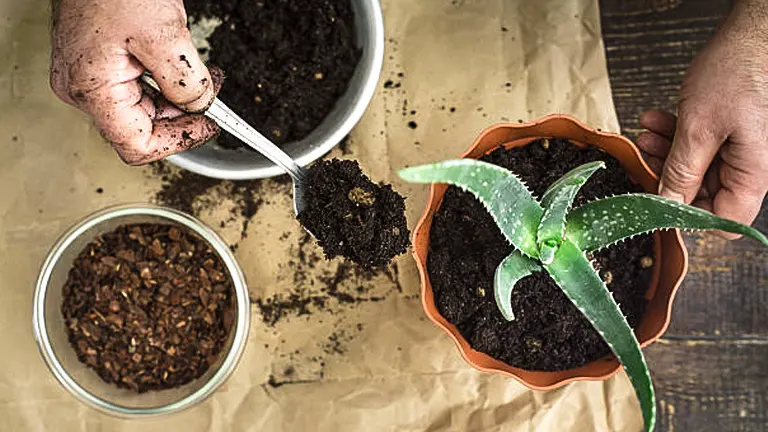
Potted houseplants require particular attention regarding fertilization due to the confined environment, which can limit nutrient availability and affect root health. Understanding the dynamics of potting soil and the interaction between pot type and fertilization frequency is crucial for maintaining healthy plants.
Understanding Potting Impacts
Pot Size and Material:
- Size: Smaller pots dry out faster but can also concentrate nutrients if not watered adequately, leading to salt buildup that can burn roots. Conversely, larger pots retain moisture for longer, potentially leading to over-watered conditions which dilute and wash away nutrients.
- Material: Plastic pots inhibit soil drying and are lightweight, ideal for indoor areas. Clay or terracotta pots are porous, promoting air and water flow, but they require more frequent watering, which can leach nutrients more quickly from the soil.
Soil Type and Drainage:
- Effective drainage is vital to prevent waterlogging, which can suffocate roots and foster fungal diseases. Use a well-draining potting mix designed for indoor plants, which typically contains perlite, vermiculite, or sand to promote moisture retention and airflow.
- Regularly check and clear drainage holes to ensure they are not blocked, as poor drainage can lead to nutrient accumulation and root damage.
Pot-Specific Fertilization Techniques
Even Distribution:
- When applying granular fertilizer, ensure it is evenly distributed across the soil surface and not piled around the base of the plant, which can cause nutrient burn to the roots.
- For liquid fertilizers, dilute as recommended on the label and apply until you see water escaping through the drainage holes to ensure the nutrients reach the root zone.
Frequency and Dosage:
- Generally, potted plants should be fertilized with a weaker solution than recommended for outdoor plants. Half-strength, monthly applications during the growing season (spring and summer) are sufficient for most species.
- Reduce the strength and frequency in autumn and entirely pause in winter, as most houseplants enter a dormant phase and excess nutrients can harm inactive roots.
Seasonal Adjustments and Advanced Tips
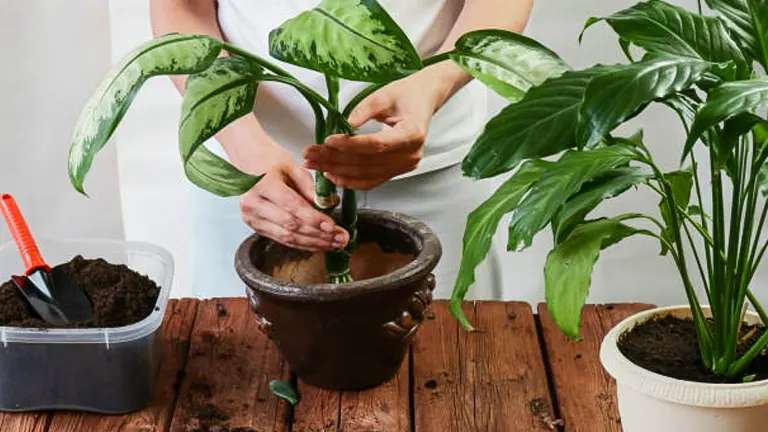
The changing seasons require adjustments in plant care, including fertilization strategies to match plant growth cycles and environmental conditions.
Customizing Fertilization Plans
Growth Phases:
- Active Growth Phase (Spring and Summer): This is when most houseplants experience a growth spurt and require more frequent fertilization. It’s the best time to use balanced or growth-promoting fertilizers (higher in nitrogen).
- Dormant Phase (Fall and Winter): During this phase, plants slow down their metabolism and prepare for rest. Minimize fertilizing to prevent the buildup of nutrients that the plants won’t use.
Environmental Factors:
- Light Levels: Plants positioned in areas with lower light may require less fertilizer compared to those in bright, indirect light.
- Temperature and Humidity: High temperatures can enhance growth, increasing nutrient demand, whereas high humidity may reduce water loss and subsequently nutrient uptake through the roots.
Monitoring Plant Health
Visual Inspection:
- Regularly inspect plant leaves and roots for signs of over-fertilization (such as salt buildup on the pot’s rim, leaf burn, or unusually fast growth).
- Signs of under-fertilization include stunted growth and pale or yellowing leaves, indicating a possible need for nutrient top-ups.
Adjusting Practices:
- If symptoms of nutrient excess appear, leach the soil by running a large amount of water through the pot to flush out excess salts.
- Conversely, if plants show signs of nutrient deficiency, a soil test can help identify which nutrients are lacking, allowing targeted fertilization.
Common Mistakes to Avoid in Houseplant Fertilization
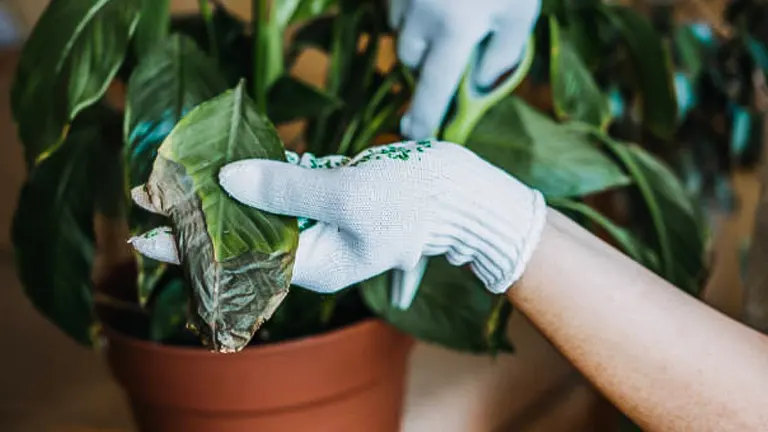
Navigating houseplant care, especially fertilization, can be tricky. Mistakes are common, but with the right knowledge, they are also preventable. This section outlines frequent pitfalls in the fertilization of houseplants and how to adeptly avoid or rectify them.
Over-Fertilization: Recognizing and Resolving
Signs of Excess:
- Salt Buildup: White, crusty deposits on the soil surface or along the pot’s rim are telltale signs of over-fertilization.
- Leaf Scorch/Burn: If plant leaves begin to turn brown at the tips or edges, or seem scorched, excess fertilizer may be the culprit.
- Stunted Growth and Wilting: Surprisingly, too much fertilizer can actually inhibit growth due to the toxic levels of salts that build up and burn the root system.
Corrective Measures:
- Leaching the Soil: This involves watering the soil thoroughly and deeply, allowing water to flush out excess salts. Repeat until runoff water is clear and free of salts.
- Repotting: In severe cases, removing the plant from its current soil and replanting it in fresh, new potting mix can help restart its growth cycle healthily.
- Adjusting Future Applications: Reduce both the frequency and concentration of fertilizer applications, observing plant response to find the optimal fertilization schedule.
Under-Fertilization: Symptoms and Solutions
Indicators of Insufficiency:
- Pale or Yellow Leaves: This often indicates a nitrogen deficiency, vital for chlorophyll production and overall vitality.
- Slow or Stunted Growth: Without adequate nutrients, plants may not reach their full growth potential and appear underdeveloped.
- Leaf Size Reduction: Smaller than normal leaves can also be a sign of insufficient nutrient supply, particularly of phosphorus and potassium.
Corrective Actions:
- Soil Testing: To accurately diagnose nutrient deficiencies, consider conducting a soil test. This will reveal which nutrients are lacking and in what quantities they should be supplemented.
- Incremental Increase: Gradually increase the frequency and quantity of fertilization, closely monitoring the plant’s response to ensure not to swing to the opposite extreme of over-fertilization.
Neglecting Manufacturer’s Instructions
Risks Involved:
- Product Misuse: Deviating from the recommended fertilizer types, ratios, or methods can lead to poor plant health and growth.
- Damaging Plants: Incorrect application can cause nutrient imbalances, potentially harming the plant more than helping it.
Best Practices:
- Follow Guidelines: Always adhere to the fertilizer manufacturer’s instructions for the best results. If uncertain, opt for less rather than more, as it is easier to add nutrients incrementally than to rectify over-application.
- Continuous Learning: Keep informed about your specific type of houseplants and their needs as this knowledge can significantly influence the success of your indoor gardening.
Related Post
- How to Fertilize a Mango Tree Effectively: Tips and Tricks for Healthy Growth
- How to Fertilize Apple Trees: Essential Tips for a Bountiful Harvest
- How to Fertilize Lemon Trees: Secrets for Thriving Citrus
- How to Fertilize Avocado Tree: A Step-by-Step Guide for Lush Growth
Conclusion
Fertilizing houseplants is a delicate balance that requires understanding the specific needs of each plant type, recognizing the signs of nutrient deficiency or excess, and adjusting care practices accordingly. By avoiding common fertilization mistakes and adhering to a plant-specific care regime, gardeners can ensure their houseplants remain healthy and vibrant throughout the year.
FAQs
- How do I know if my houseplant needs fertilizer?
Look for signs such as slow growth, pale or yellowing leaves, and a general lack of vitality, which can indicate nutrient deficiency. A healthy, unfertilized plant typically has deep green leaves and steady growth according to its species. - What is the best fertilizer to use for indoor plants?
A balanced, water-soluble fertilizer (e.g., 10-10-10 NPK ratio) is suitable for most houseplants. For flowering plants, use a fertilizer with a higher phosphorus content to promote blooms. Succulents and cacti prefer a fertilizer with lower nitrogen content. - Can I over-fertilize my houseplants? What are the signs?
Yes, over-fertilization is common and can damage plants. Signs include salt buildup on the soil surface, browned or scorched leaf edges, and wilted leaves despite adequate watering. If you suspect over-fertilization, leach the soil with clean water and reduce future fertilizer applications. - How often should I fertilize my houseplants during the winter?
Most houseplants enter a dormant period in winter and require little to no fertilizer. You can reduce the fertilizing frequency to once every 2-3 months or pause entirely until spring when the growing season resumes. - Is it necessary to adjust the fertilizer concentration for houseplants?
Yes, it’s advisable to dilute your fertilizer to half the strength recommended on the package, especially for indoor plants. This prevents nutrient overload and reduces the risk of root burn. - What’s the difference between slow-release and liquid fertilizers, and when should I use each?
Slow-release fertilizers deliver nutrients over several months and are ideal for continuous support without frequent application. They’re best used at the beginning of the growing season. Liquid fertilizers provide a quick nutrient boost and are ideal for plants with immediate needs, applied every few weeks according to the plant’s growth phase. - How can I tell if my fertilization schedule is working?
Monitor your plant’s response after applying fertilizer. Signs of effective fertilization include new growth, such as fresh foliage or flowers, and an improvement in overall color and vitality. Adjust the schedule based on the plant’s response, cutting back if you notice signs of over-fertilization. - Do all houseplants have the same fertilization needs?
No, fertilization needs vary widely between different types of houseplants. Foliage plants generally need a nitrogen-rich fertilizer for leaf development, while flowering plants require more phosphorus to bloom. Succulents and cacti need minimal fertilization and are often harmed by excessive nutrients.
Regularly fertilize your houseplants using the right balance to keep them healthy and thriving. Adjust as needed based on the season and their growth responses. Happy planting!

Emma Hudson
Forestry AuthorEmma's experience in farming shapes her detailed guides on gardening and farming tools, providing practical, actionable advice grounded in real-world experience. Her work targets both newcomers and experienced farmers, aiming to enhance their practices with a mix of traditional wisdom and modern techniques. By making complex agricultural concepts accessible, Emma's guides serve as valuable tools for those navigating the challenges of contemporary farming, offering strategies for sustainable success.












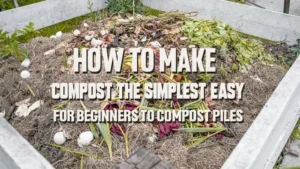
Leave your comment